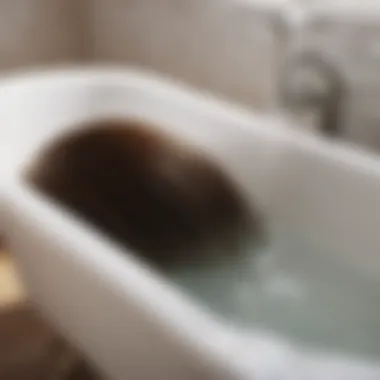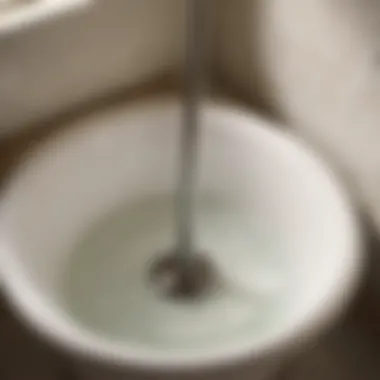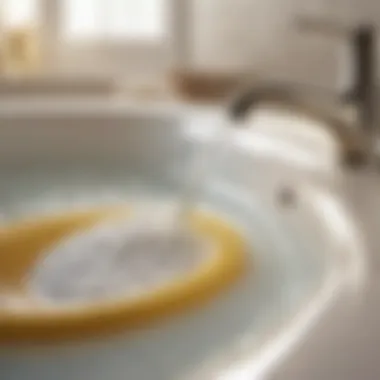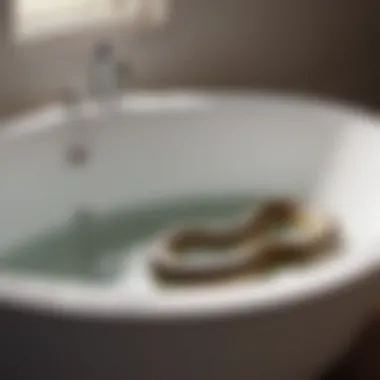Master the Art of Unclogging a Bathtub Drain with this Comprehensive Guide


Materials:
- Plunger
- Drain snake
- Baking soda
- White vinegar
- Hot water
Detailed Instructions:
- Begin by removing the bathtub stopper to access the drain opening.
- Use a plunger to create suction and dislodge any blockages in the drain.
- If the plunger doesn't work, utilize a drain snake to physically remove debris from the drain.
- Mix 1 cup of baking soda with 1 cup of vinegar and pour it down the drain. Let it sit for 30 minutes.
- Follow up with hot water to flush out the remaining residue.
Technical Aspects:
- Timing: Allow at least 1 hour for the unclogging process.
- Tools: Plunger, drain snake, measuring cup
- Critical Techniques: Ensure a tight seal with the plunger for efficient suction.
Sequential Steps:
- Remove the stopper
- Plunge the drain
- Use the drain snake if necessary
- Apply the baking soda and vinegar mixture
- Flush with hot water
Troubleshooting Tips:
- If the drain remains clogged, repeat the baking soda and vinegar treatment or consider using a chemical drain cleaner following safety precautions.
Understanding the Issue of a Clogged Bathtub Drain
As we embark on the journey of unclogging a bathtub drain, a crucial foundation lies in comprehending the intricacies of this common household nuisance. Understanding the issue of a clogged bathtub drain not only equips us with the knowledge to troubleshoot effectively but also serves as a preventive measure for future occurrences. By delving into the root causes and warning signs, we can proactively address potential blockages before they escalate.
Common Causes of Bathtub Drain Clogs
Hair Accumulation
Hair accumulation ranks among the primary perpetrators of bathtub drain blockages. The insidious nature of hair strands entwining and congealing within our drains leads to restricted water flow, eventually resulting in a clog. Its tenacity and propensity to accumulate over time make it a formidable foe in maintaining a clear drain system. While human manes enhance our aesthetics, neglecting the aftermath of shedding can quickly transform into a plumbing predicament, necessitating immediate attention in our unclogging endeavors.


Soap Scum Buildup
Another stealthy culprit behind bathtub drain obstructions is soap scum buildup. As we indulge in luxurious baths or refreshing showers, the residual film left behind by soap mixes with minerals in the water, creating a sticky residue that clings to drain pipes. Over time, this buildup solidifies, attracting debris and impeding water passage. While indulging in cleanliness, the unintended consequence of soap scum accumulation underscores the necessity of regular drain maintenance to thwart potential clogs.
Foreign Objects
Innocuous everyday items, such as jewelry, bath products' caps, or children's toys, can inadvertently find their way into our drains, causing impediments. Foreign objects disrupt the smooth flow of water, leading to blockages and functional impairments. Vigilance in monitoring what goes down our drains and implementing safeguards against unintended items entry can mitigate the risk of foreign object-induced clogs, ensuring uninterrupted drainage efficiency.
Hard Water Deposits
The pervasive presence of hard water in plumbing systems fosters the deposition of mineral buildup within drain pipes. Calcium and magnesium compounds in hard water precipitate over time, forming stubborn deposits that constrict water flow. These mineral accumulations not only diminish drainage efficacy but also contribute to corrosion and plumbing damages if left unaddressed. By recognizing the adverse impacts of hard water deposits, we can adopt preventative measures to safeguard our drains against mineral incrustations and resultant clogs.
DIY Methods to Unclog a Bathtub Drain
Clogged bathtub drains can be a recurring nuisance in households, disrupting daily routines and causing frustrations. This section delves into essential DIY methods to tackle bathtub drain clogs, providing homeowners with cost-effective and practical solutions that can be implemented without professional assistance. By empowering individuals to take matters into their own hands, DIY methods present a proactive approach to resolving this common issue, promoting self-reliance and saving time and resources in the long run.
Using a Plunger
Steps to Plunge a Bathtub Drain
Steps to plunge a bathtub drain involve creating a tight seal around the drain opening with the plunger and applying firm pressure in a rhythmic up-and-down motion. This technique helps dislodge blockages by creating suction and pushing trapped debris through the drain pipes. The simplicity and effectiveness of plunging make it a go-to method for minor to moderate clogs, offering a quick fix that requires minimal effort and investment. However, cautious usage is advised to prevent any potential damage to the drain or plumbing system.
Tips for Effective Plunging
Effective plunging relies on proper technique and adequate force to generate sufficient pressure for clearing the clog. Ensuring a secure seal between the plunger and drain surface is vital for maximum suction power. Additionally, maintaining a steady and controlled plunging rhythm enhances the effectiveness of this method. By following these tips, homeowners can optimize the plunging process and achieve successful results in unclogging their bathtub drains.
Homemade Drain Cleaners
Baking Soda and Vinegar
The combination of baking soda and vinegar offers a natural and chemical-free alternative for clearing minor drain blockages. When mixed and poured down the drain, the foaming reaction helps break down organic matter and residue, facilitating smoother water flow. This eco-friendly solution is gentle on pipes and septic systems, making it a preferred choice for environmentally conscious individuals. However, repeated or excessive use may be required for tough clogs.


Salt and Baking Soda Mixture
A concoction of salt and baking soda serves as an abrasive cleaner for stubborn clogs, dissolving grease and grime that accumulate in the pipes. This homemade remedy not only clears the blockage but also helps eliminate foul odors, leaving the drain smelling fresh and clean. While effective, this mixture may not be suitable for all types of clogs, requiring careful application and sufficient rinsing to prevent potential residue buildup.
Manual Removal of Debris
Using a Drain Snake
Employing a drain snake involves inserting a flexible auger into the drain opening and twisting it to capture and extract trapped debris. This physical method allows targeted removal of deep-seated blockages that cannot be reached through other means. The versatility of a drain snake makes it adaptable to various drain sizes and configurations, offering a comprehensive solution for more challenging clogs. However, proper usage is crucial to avoid causing damages to the pipes.
Removing Hair and Grime
Manual removal of hair and grime entails directly extracting visible blockages from the drain using gloved hands or specialized tools. This hands-on approach allows homeowners to physically identify and dislodge accumulated debris, preventing further buildup and restoring proper drainage. While effective for surface-level clogs, this method may require regular maintenance to address recurring issues and maintain optimal drain performance.
Professional Solutions for Stubborn Bathtub Clogs
In addressing the pervasive issue of clogged bathtub drains, the section on Professional Solutions for Stubborn Bathtub Clogs stands out as a crucial component within this comprehensive guide. When common DIY methods and homemade remedies fall short, turning to professional solutions becomes essential. This section delves into the specialized techniques and tools that plumbing experts utilize to tackle stubborn clogs effectively. With an emphasis on efficiency and lasting results, this segment aims to equip readers with the knowledge needed to make informed decisions when facing challenging drainage issues.
Chemical Drain Cleaners
Precautions and Usage Tips
When exploring the realm of professional solutions for unclogging bathtub drains, Chemical Drain Cleaners emerge as a prominent option. These products offer a potent formula designed to dissolve tough clogs, providing a convenient alternative to manual interventions. In this sub-section, we delve into the specific aspects of Precautions and Usage Tips that are crucial for maximizing the effectiveness of chemical drain cleaners while ensuring safety and environmental consciousness. Highlighting the significance of following manufacturer instructions meticulously, we underscore the importance of wearing protective gear and ventilating the area adequately during application. While chemical drain cleaners present a quick and efficient solution for stubborn clogs, it's essential to weigh the benefits against potential risks such as pipe corrosion and exposure to harmful substances. By dissecting the unique features of Precautions and Usage Tips, readers gain a comprehensive understanding of how to harness the power of chemical drain cleaners responsibly and effectively.
Plumbing Snake Service
How a Professional Clears a Bathtub Drain
Delving deeper into the arsenal of professional solutions for combating persistent bathtub clogs, Plumbing Snake Service emerges as a versatile and potent tool in the hands of experienced plumbers. In this section, we unravel the intricacies of how professionals utilize plumbing snakes to dislodge and remove obstructions within the drain system. By highlighting the flexibility and reach of plumbing snakes, we showcase why this method is favored for tackling deep-seated clogs that resist conventional approaches. Exploring the unique feature of How a Professional Clears a Bathtub Drain, we illuminate the benefits of precise and targeted clog removal without causing damage to the plumbing infrastructure. While plumbing snakes offer an effective means of restoring optimal drain function, it's crucial to acknowledge potential drawbacks such as the risk of pushing clogs further down the pipe if not used correctly. By providing insights into the advantages and considerations of plumbing snake services, readers are empowered to make informed decisions when enlisting professional help for stubborn bathtub drain clogs.
Preventive Measures to Avoid Future Clogs


In this comprehensive guide to unclogging a bathtub drain, the segment on Preventive Measures to Avoid Future Clogs plays a crucial role in ensuring long-term maintenance and preventing recurring clogs. By implementing proactive strategies, homeowners can save time and money while maintaining a smoothly flowing drain system. While addressing current clogs is essential, taking preventive measures is equally important to avoid facing such issues repeatedly.
Regular Maintenance Practices
- Hair Catchers
Hair Catchers
Hair catchers are a specific aspect of regular maintenance practices that contribute significantly to preventing clogs in bathtub drains. Their key characteristic lies in effectively trapping hair and other debris to prevent blockages in the drain pipes. This makes them a popular choice for individuals looking to prevent clogs without resorting to harsh chemicals or expensive plumbing services. The unique feature of hair catchers is their ability to catch debris before it enters the drainage system, reducing the chances of clogs forming over time. While they provide excellent protection against blockages, some users may find them tedious to clean regularly, but the benefits of avoiding clogs make them a worthwhile investment.
- Monthly Drain Cleaning
Monthly Drain Cleaning
Monthly drain cleaning is another vital aspect of regular maintenance practices that contribute to preventing future clogs. By incorporating this routine into household maintenance, homeowners can proactively remove accumulated debris and prevent the buildup of substances that can lead to clogs. The key characteristic of monthly drain cleaning is its ability to maintain the free flow of water through the pipes, minimizing the risk of blockages. This approach is a beneficial choice for this article as it promotes a proactive stance towards drain maintenance, reducing the likelihood of encountering severe clogs. The unique feature of monthly drain cleaning is its consistency, ensuring that potential clog-causing elements are continuously removed from the drainage system. While it may require some time and effort on a regular basis, the advantages of maintaining a clear drain far outweigh the inconvenience of periodic cleaning.
Awareness of What Goes Down the Drain
- Proper Disposal of Waste
Proper Disposal of Waste
Proper disposal of waste is a critical aspect that contributes to preventing clogs in bathtub drains. By highlighting the importance of disposing of waste properly, homeowners can significantly reduce the chances of blockages occurring. The key characteristic of proper waste disposal lies in avoiding the introduction of substances that can accumulate and clog the drain system, such as grease, large food particles, and non-biodegradable materials. This practice is a beneficial choice for this article as it emphasizes the role of responsible waste management in maintaining a functional drainage system. The unique feature of proper waste disposal is its ability to preserve the integrity of the plumbing network, preventing costly and inconvenient clogs. While it may require mindfulness and adherence to disposal guidelines, the advantages of preventing drain blockages make it a worthwhile habit for homeowners to adopt.
Conclusion
In this ultimate guide to unclogging a bathtub drain, we have unraveled the complexities of dealing with this common household issue. By understanding the causes, signs, and methods to address a clogged bathtub drain, you are now equipped with the knowledge to tackle this problem effectively. The importance of the conclusion lies in summarizing the key takeaways and empowering you to maintain a smoothly flowing drain without the fear of future clogs.
Final Thoughts on Bathtub Drain Clogs
Empowered to Handle Clogs
Empowering yourself with the knowledge and skills to handle bathtub drain clogs is essential for maintaining a functional drainage system in your home. By implementing the DIY methods and preventive measures outlined in this guide, you take control of the situation and reduce the need for professional assistance. The key characteristic of being empowered to handle clogs is the independence it provides in managing an otherwise frustrating issue. This self-reliance not only saves time and money but also instills a sense of accomplishment in effectively resolving drain clogs. While there may be challenges in the process, the ability to troubleshoot and address clogs on your own is a valuable skill that enhances your ownership of home maintenance. The unique feature of being empowered to handle clogs is the satisfaction of restoring proper drainage without relying on external help. This sense of self-efficacy empowers homeowners to tackle similar challenges confidently, making it a popular choice for those seeking autonomy in maintaining their household.
Maintaining a Smoothly Flowing Drain
Keeping your bathtub drain running smoothly is not just about addressing clogs when they occur but also about adopting preventive measures to avoid future blockages. Maintaining a smoothly flowing drain involves regular upkeep and a proactive approach to cleaning and caring for your drainage system. The key characteristic of this practice is the ability to prevent clogs before they become major plumbing issues, saving you from the inconvenience and expense of extensive repairs. By incorporating simple habits such as using hair catchers and conducting monthly drain cleaning routines, you ensure that water flows freely through your drain, reducing the risk of blockages. The unique feature of maintaining a smoothly flowing drain is the continuous effort it requires to preserve the efficiency of your plumbing system. While it involves some diligence and commitment, the long-term advantages of preventing clogs and maintaining optimal drainage make it a worthwhile investment. Consistent drain maintenance leads to fewer disruptions in your daily routine and reinforces the longevity of your plumbing infrastructure, making it a beneficial choice for safeguarding your home's functionality.







